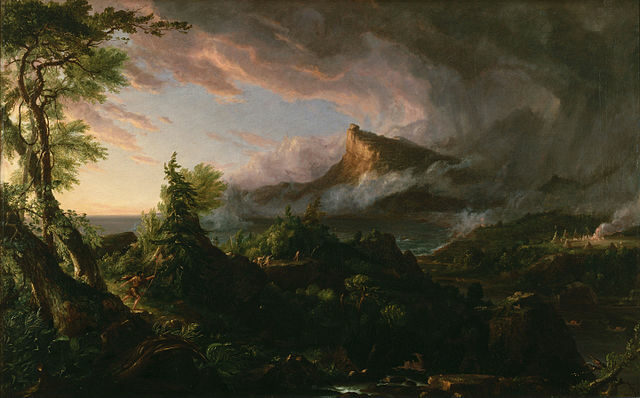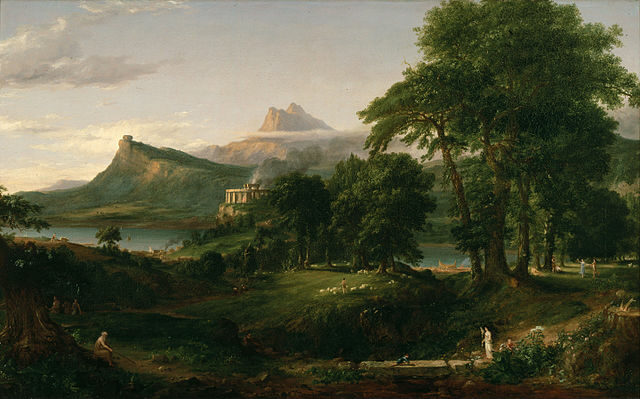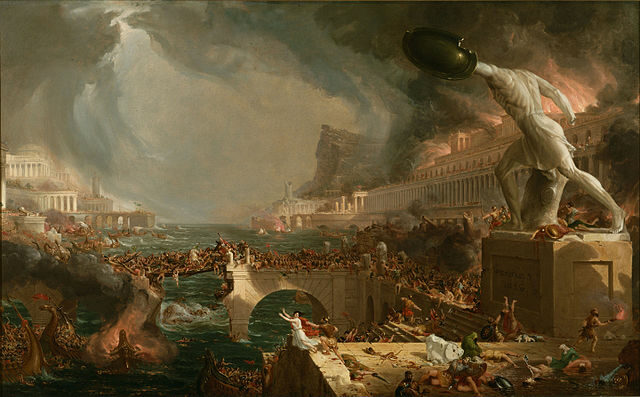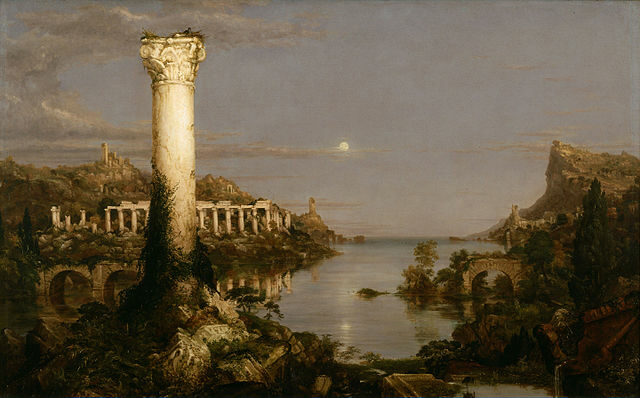Art as Ideas: Thomas Cole’s The Course of Empire
For his stunning depictions of social and political theory, “Thomas Cole stands as one of the most influential fine artists in the history of liberal thought.”
The New York of 1836 was already well along its way to wresting national political and cultural preeminence from Boston, widely recognized at the time as the nation’s heartland, the “Cradle of Liberty.” Throughout the Jacksonian period, propelled by the generation of whiggish, conservative, antiquarian “Knickerbocker” writers like Washington Irving and continuing through a new generation of artists and intellectuals calling themselves the “Young Americans,” New York assumed the position as the cultural capital of the United States. As historian Perry Miller argued in his justly famous The Raven and the Whale (1956), publisher and literati Evert Duyckinck’s literary circle, “The Tetractys Group,” purposively created the Young America movement in the mid-1830s with the specific goal of birthing an authentically American national culture.
The Loco-Foco movement, inaugurated by radical Jeffersonians and aimed at destroying all vestiges of Old World feudalism in the United States, provided radical ideological fuel to the Young American artists’ nationalistic, romantic fire. The confluence, therefore, of New York Knickerbockerism and Locofocoism, more than any other factor, launched Young America as a full-fledged, generational movement of its own. Fine artist Thomas Cole’s work stands as the best visual representations of the ideas and the romantic fury which drove Young Americans.
Born in Lancashire, Britain in 1801, the young Cole spent short periods in Philadelphia and Ohio, before he permanently settled in New York City. To supplement his family’s meager income, Thomas taught himself to paint landscapes, quickly excelled at his new craft, and caught the attentions of wealthy New York patrons. Personally conservative and of a whiggish political temperament, Cole was skeptical of Democrats’ claims to moral supremacy by virtue of their demagogic appeals to King Mob. Despite this somewhat “Older American” politics, Cole was also life-long friends with the rather radical locofoco Democrat William Cullen Bryant. No mere friendship, the two men’s connection represents the reciprocal effects of locofoco politics and Young American art. When fused, the two produced explosive results, ranging from Thomas Cole’s authentically American form of landscape painting to Bryant’s own lifelong struggle for political abolitionism. Bryant’s generation of Knickerbocker literati and the new locofoco intelligentsia provided Young American fine artists with imagery and subject matter, new techniques, structural support for their paintings including publicity and exposure, and a constant stream of radical republican ideology which both learned from and positively informed Young American art.
Landscape painters generally used their genre as a method of critiquing historical development and Man’s moral and spiritual position in the world. Through depictions of the land, artists like Cole juxtaposed Man’s constant transience and restless pursuits against the relatively constant state of the natural world. As such, landscapes provided artists an opportunity to advance their own visions of spiritual life, ethics, politics; they were able to present their own theories of psychological, social, and historical development. Few places on the planet could provide the level of daily evidence of revolutionary change than Cole’s own New York City in the 1830s. The emergent de facto national capital buzzed with locofoco radicalism, incipient concepts of “Manifest Destiny,” and a heady atmosphere of constant and bewildering technological and economic progress.
Political pessimists like Cole, however, harbored deep suspicions of democratic virtue. Classical liberal theories of history, including the romantic republic version advanced by the New York locofocos, stressed that historical change was the result of inevitable and relatively constant individual and social battles for liberty against the forces of power. The dualistic dynamic not only described man’s progression through the individual life-cycle, but the development, culmination, and decline of civilizations. Cole translated the romantic (that is, ideas-driven) model of historical progression and the radical liberal values permeating his city into landscapes of transfixing beauty, carrying powerful moral instructions to the viewer. His paintings did not merely reflect the ideas of philosophers, but made positive contributions through visual media. His masterful The Course of Empire is without equal in its explorations of historical theory and themes. It presents a stadialist interpretation of the liberal theory of history, showing stage-by-stage the timeless and cyclical conflict between liberty and power.
Stage One: The Savage State

The Savage State is dominated by a vast and swirling wilderness. This is the perfect image of liberty: the lone individual, nakedly braving the world on his own, hunting his game across the land unhindered wherever it might go. There exist only the barest indications of civilization or complex society, including a clustered handful of tipis, some of which emit thin wisps of smoke from their roofs. There stands at the center of the painting a true natural monument, the towering height and Power of this particular natural world: a great rocky mountain and its cloud-shrouded summit scratching the skies. The Savage State of civilization represents pre-agricultural hunter-gathering societies, especially reminiscent of pre-modern Native American life. When man’s power over nature (and, consequently, other men), was at its lowest point, he correspondingly enjoyed his greatest amount of Liberty. Virtually unencumbered by the innumerable desiderata of settled society, our subject civilization is practically indistinguishable from nature.
Stage Two: The Arcadian or Pastoral State

For the second piece in the series, Cole shifts the tone of color from dark, brooding, and lonely, to light, effervescent, and hopeful. Closely resembling Homeric Greece, the Arcadian or Pastoral State of civilization has tamed the savage wilderness, exercised man’s own faculties for power, and in turn lessened man’s enjoyment of perfect liberty. Having come far from chasing a single deer through an endless forest, man now herds his own small flocks of animals, cultivates small gardens, and even improves his environment by constructing roads, boats, clothing, simple farming implements, and what appears to be a small town of wooden houses. Most obviously, our subject civilization has introduced social hierarchies along with increasing amounts of power and wealth. In the center stands a lone temple, built of great stone slabs, the smoke of recent offerings pouring from the rooftop. All of man’s creations--his exercises of power over nature--remain, however, well below the heights of the rocky mountaintop. In fact, yet another mountain, even more towering and imposing than the last, has appeared in the farthest reaches of the background as if to remind the viewer that the subject society remains extremely young in comparison to Nature’s timelessness.
Stage Three: The Consummation of Empire

At the height of our subject civilization’s Power and glory, the trappings of Empire are on full public display. Nature has sunk to relative insignificance and virtually faded from the scene. What does remain has been thoroughly incorporated into urban life: a fully navigable harbor replete with bridges and vessels of all kinds, a hillside paved over with man-made mountains of granite and polished marble temples and manses, no trace of the original forest whatsoever, no wildlife in sight, and our once-high mountain now paling in comparison to the vast heights achieved by advanced man’s own buildings and monuments. As man increased his power over nature, he clearly expanded upon Arcadian organized religious and social life. With the Consummation of Empire comes also the consummation of social hierarchy--abundant visible distinctions between rulers and ruled, masters and slaves, priests and laity, rich and poor. While the tone of the painting is unquestionably bright and hopeful, close observers must be uncomfortably aware of the seething conflicts forming the young empire’s foundations.
Cole believed that history operated cyclically. While knowledge could advance in fits and spurts, revolutionizing the world from time to time, man’s virtue tended to lag significantly far behind. We are, therefore, virtually condemned to repeat the mistakes of the past just as we attempt to learn from them. In our endless attempts to improve our world--to expand both our power over the forces of nature and to protect our equally natural liberty--we set in motion a series of dialectical conflicts, both generative and destructive. Man has learned and accomplished a great deal since his time as a “savage,” but his rise in this particular civilization has been marked by conquest and exploitation stretching beyond the mere felling of surrounding forests. The empire has, through the projection of power abroad, exploited and constrained the liberty of its neighbors. However, history simply did not allow for actions without equal and opposite reactions.
Stage Four: Destruction

Just as no individual human being may escape the life cycle, Destruction suggests that no civilization which has chosen to abandon perfect liberty in order to exercise power may escape the judgment of history. Here is an absolute orgy of death as the Empire’s enemies destroy our subjects. Wholesale slaughter reigns in the streets, makeshift siege engines take the place of crumbling infrastructure, the mansions and temples once rising to the highest peaks of the visible world now burn to cinders. Whether the destroyers are rebellious slaves, a subjugated neighbor, or a still more powerful empire invading from abroad, we cannot be sure. Regardless, the viewer cannot but feel that the empire has in some significant sense earned its fate. Nature, for her part, prepares to reclaim the scene, once again gathering her own forces from the swirls of flame, sea, and smoke. Man’s monuments to war still provide the highest visual cues, but the solitary mountain peak has once again risen above the hillside palaces and captured the center of the frame.
Stage Five: Desolation

The Desolation of Cole’s subject civilization in now complete, and the historical cycle turns into its final phase. The mountain summit has retired to the edge and nature has begun her long, slow re-conquest of the land and sea. The sky is still; the clouds thin, nonthreatening wisps; and innumerable hosts of flora steadily tear down man’s surviving monuments to his power. The lone, pale moon and its undisturbed reflection on the harbor surface control the center of the frame. There is barely a single stirring of life, not a single sign of creatures enjoying either liberty or power. For all its incredible strength and wealth during the Consummation of Empire, the subject society’s power could not protect it from cyclical collapse. To Cole and his fellow Young Americans, this very process--the dialectical relationship between the liberty interest and the power interest--quite literally was history and history was inescapable. Not merely inescapable, however: the historical process was also necessary and even beneficial. The tone of Desolation, while somber and lonesome, is undoubtedly peaceful. Man, after all, still exists apart from the life of any particular civilization, and so long as Nature continues to provide the elements of life, history may begin anew atop the ruin of elder empires. With any luck, man may gradually learn the lessons of the past, imparted from cycle to cycle, lifetime to lifetime, generation to generation. As knowledge and virtue accumulate together, Man may gradually advance his way through history with increasingly tangible improvements in daily life. His message remains fundamentally pessimistic, however, warning audiences that they themselves stood at the peak of another historical cycle. What they did in their lifetime--the course Young America steered for the United States and much of the world--would determine whether the point of consummation or destruction and desolation lay immediately ahead.
Politics held forth no hope to those who wished to break the cycle of history, but Cole saw in the land timeless, cautious lessons of inestimable value. In his work, North America is a frontier in history more so than a geographical expression; it is nature holding a mirror to humanity, showing his unquenchable desires for both liberty and power. On the frontier, man endlessly battled for power over nature and a wide variety of other enemies, each in turn barely scratching out a living from the Earth. As the world rapidly transformed from Early Modern to Decidedly Modern, Cole challenged his fellow Young Americans to remain knowledgeable and wise in their exercise of previously unimaginable power. Without sufficient virtue maintaining the moral integrity of the republic, the empire would surely rise to take its place.
Thomas Cole’s importance and influence as an American artist exploded during the mid-1830s and his career flourished in the early 1840s. He deeply influenced his immediate peers and successive generations of American artists. He transformed the landscape genre from a reflective art to a medium of expressing historical, social, and political theory. In a speech to the American Art Union, Joel Headley once implored his audience: “Give me the control of the art of a country, and you may have the management of its administration…The tariff, internal improvements, banks, political speeches and party measures…all together do not so educate the soul of the nation.” By producing titanic icons of classical liberal, romantic, locofoco historical and social theory, Thomas Cole stands as one of the most influential fine artists in the history of liberal thought.
Select Bibliography:
Bellis, Peter. Writing Revolution: Aesthetics and Politics in Hawthorne, Whitman, and Thoreau. Athens, Georgia: The University of Georgia Press. 2003.
Bigelow, John. William Cullen Bryant. New York: Chelsea House Publishers. 1980. (Original printing: 1890).
Brown, Charles H. William Cullen Bryant. New York: Charles Scribner’s Sons. 1971.
Callow, James T. Kindred Spirits: Knickerbocker Writers and American Artists, 1807-1855. Chapel Hill: The University of North Carolina Press. 1967.
Ferber, Linda, ed. Kindred Spirits: Asher B. Durand and the American Landscape. New York: Brooklyn Museum. 2007.
Handlin, Lilian. George Bancroft, The Intellectual as Democrat. New York: Harper & Row Publishers. 1984.
Lawson, Andrew. “’Song of Myself’ and the Class Struggle in Language,” Textual Practice 18, No. 3 (2004): 377-394.
Miller, Perry. The Raven and the Whale: The War of Words and Wits in the Era of Poe and Melville. New York: Harcourt, Brace & World, Inc. 1956.
Reynolds, David S. Walt Whitman’s America: A Cultural Biography. New York: Knopf. 1996.
Stafford, John. The Literary Criticism of ‘Young America:’ A Study in the Relationship of Politics and Literature, 1837-1850. Berkeley: University of California Press. 1952.
Truettner & Wallach, eds. Thomas Cole: Landscape into History. New Haven: Yale University Press. 1994.
Tymn, Marshall, ed. Thomas Cole’s Poetry: The Collected Poems of America’s Foremost Painter of the Hudson River School Reflecting His Feelings for Nature and the Romantic Spirit of the Nineteenth Century. York, PA: Liberty Cap Books. 1972.
Watson, Harry L. Liberty and Power: The Politics of Jacksonian America. New York: Hill & Wang. 1990.
Widmer, Edward. Young America: The Flowering of Democracy in New York City. New York: Oxford University Press. 1999.
Wilentz, Sean. Chants Democratic: New York City & the Rise of the American Working Class, 1768-1850. New York: Oxford University Press. 1984.
Wilentz, Sean. The Rise of American Democracy: Jefferson to Lincoln. New York: W. W. Norton & Company. 2005.